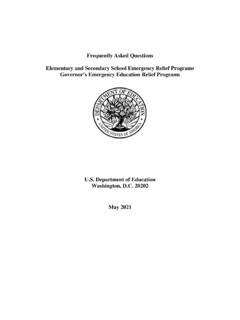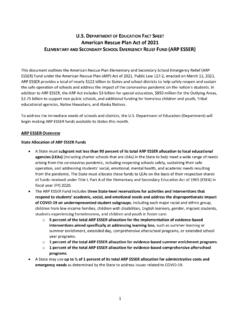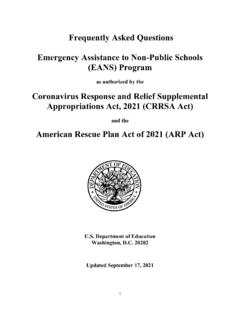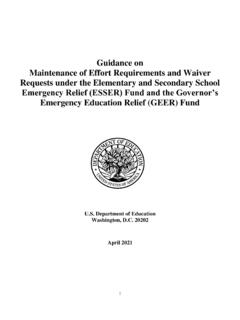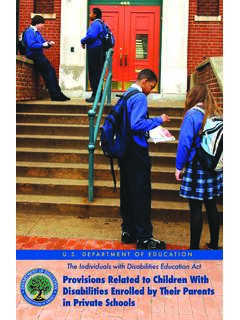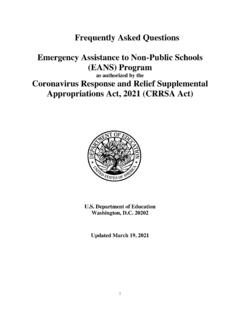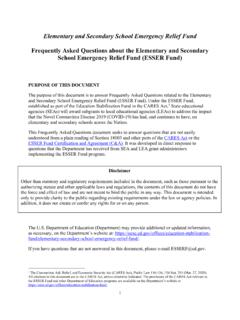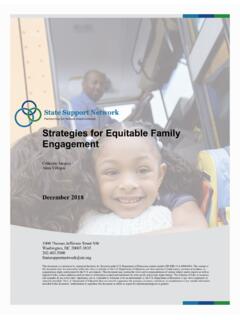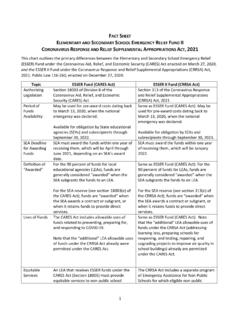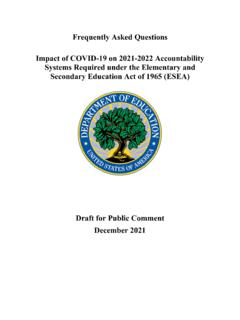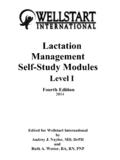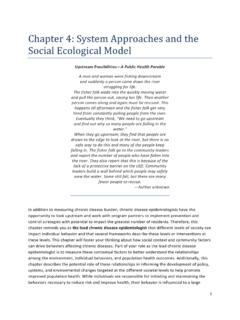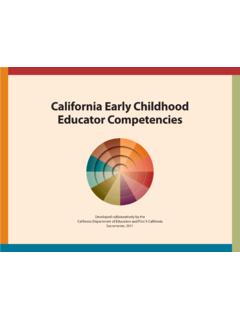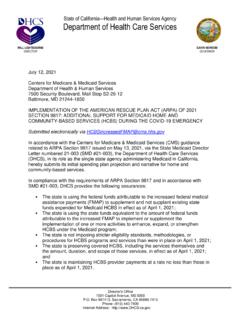Transcription of WASHINGTON, DC 20202
1 THE SECRETARY OF education WASHINGTON, DC 20202 December 16, 2021 Dear Colleagues: As schools work hard to provide safe, in-person learning and address the social, emotional, mental health, and academic impact of COVID-19, we have heard directly from chief State school officers, superintendents, educators, and families about the harmful impacts of shortages of educators and other school staff. These impacts include difficulty providing student transportation, interrupted access to meals and critical services such as mental health services, larger class sizes, a greater number of students being taught by substitute teachers and teachers who are not certified in the area assigned to teach, and, in the most extreme cases, disruptive school Preexisting teacher shortages in critical areas such as special education ; bilingual education ; science, technology, engineering, and math; and career and technical education have been further exacerbated by COVID-19 directly impeding student access to educational opportunity.
2 According to a recent Ed Week Research Center survey,2 one in four district leaders and principals are reporting severe staffing shortages; and according to a recent survey conducted by the National Association of Secondary School Principals, 68 percent of principals surveyed are concerned about teacher shortages and report it has been more difficult to hire qualified teachers since History has shown that shortages disproportionately impact students of color, students from low-income backgrounds, students with disabilities, and often rural The department of education (ED) is committed to supporting districts and schools across this country in addressing teacher and staff shortages, minimizing disruption to in-person learning, and meeting student needs. That is why we are urging you to use resources from the $122 billion made available through the American Rescue Plan Act of 2021 (ARP) (Pub.)
3 L. 117-2) Elementary and Secondary School Emergency Relief (ARP ESSER) Fund and a portion of the $350 billion made available through the ARP s Coronavirus State and Local Fiscal Recovery Funds (SLFRF) to ensure that students have access to the teachers and other critical staff they 1 St. George, D., and Strauss, V. The Principal is Cleaning the Bathroom: Schools Reel with Staff Shortages. The Washington Post, 5 Dec. 2021. 2 Lieberman, M. How Bad Are School Staffing Shortages? What We Learned by Asking Administrators. education Week, 22 Oct. 2021, 3 NASSP Survey Signals a Looming Mass Exodus of Principals from Schools. National Association of Secondary School Principals, 8 December 2021, 4 Goldhaber, D. & Gratz, T. (2021). School District Staffing Challenges in a Rapidly Recovering Economy. CEDR Flash Brief No.
4 11082021-1. University of Washington, Seattle, WA.; Sutcher, L., Darling-Hammond, L., & Carver-Thomas, D. (2016). A coming crisis in teaching? Teacher supply, demand, and shortages in the Palo Alto, CA: Learning Policy Institute; and Cardichon, J., Darling-Hammond, L., Yang, M., Scott, C., Shields, P. M., & Burns, D. (2020). Inequitable opportunity to learn: Student access to certified and experienced teachers. Palo Alto, CA: Learning Policy Institute. 2 need to support their success during this critical period. This includes moving quickly to implement short-term strategies while also considering longer-term investments. Let us be clear: ARP provides vital resources to hire additional educators and school staff and to improve compensation to recruit and retain educators and school staff. School districts should act with urgency to keep schools open for in-person learning and ensure they do not waste this opportunity to make critical investments.
5 To this end, this letter describes (1) evidence-based and promising short- and long-term strategies for addressing teacher and staff shortages that can be funded through ARP ESSER and (2) examples of how ARP and previous relief funds are already being used to attract and retain teachers and staff. These strategies can help to fill currently open positions and add and fill new roles, such as providing one-time initial hiring incentives, or short-term investments in additional staff to support students and educators and increased needs. The current needs of our students, families, and educators call on us to act and use the Federal resources made available to respond to this crisis. We must do everything we can right now to support our students during this critical year by addressing the impact of the last few years on their social, emotional, mental health, and academic needs.
6 Strategies for Hiring and Retaining Qualified and Effective Educators 1. Increase Educator and Staff Compensation5 The most common reason educators have cited for leaving school employment in the last year is stress, followed by insufficient Many school leaders are increasing wages by offering hiring and retention bonuses, working towards permanent salary increases, or providing premium pay that help educators receive the compensation they deserve and keep them in the profession, and we encourage others to continue to work towards increasing compensation. Hiring and retention bonuses may provide additional relief from some of the stresses caused by COVID-19. While some districts have expressed concern about investing in increasing compensation with short-term recovery funds, our nation s children need support now, and many states and districts are already choosing to use ARP ESSER funds to address immediate shortage needs.
7 For example, West Contra Costa County Unified School District is providing $6,000 signing bonuses for Districts in Oklahoma, North Carolina, New Jersey, and elsewhere are offering a range of cash incentives for new teachers, particularly in struggling and underserved 5 Ulrich Boser and Chelsea Straus, Mid- and Late-Career Teachers Struggle with Paltry Incomes (Washington: Center for American Progress, 2014), available at ; and Linda Darling-Hammond, Roberta Furger, Patrick M. Shields, and Leib Sutcher, Addressing California s Emerging Teacher Shortage: An Analysis of Sources and Solutions (Palo Alto: Learning Policy Institute, 2016). 6 Diliberti, Melissa Kay, et al. Stress Topped The Reasons Why Teachers Quit, Even Before COVID-19. RAND Corporation, 22 Feb. 2021, 7 Klapper, Rebecca. To Fill Teaching Vacancies, Some Districts Offer Thousands in Signing Bonuses.
8 Newsweek, Newsweek, 22 Sept. 2021, 8 Gecker, Jocelyn. Covid-19 Creates Dire US Shortage of Teachers, School Staff. AP NEWS, Associated Press, 23 Sept. 2021, 3 Indiana plans to launch a program to provide more than $ million in ARP ESSER funds and Individuals with Disabilities education Act, Part B funds to support licensure in high-need areas, and the Indianapolis Public Schools plans to provide a three percent pay Flexibilities can also be used by states and districts to bring retired educators back into the school for the next year or two. The Internal Revenue Service (IRS) has issued FAQs clarifying that, in some instances, retirees can return to work and still receive their As an added incentive to retain current staff eligible for retirement, employees can in some cases begin receiving pension payments while still working.
9 And where it is not currently allowed, pension plans can be amended to permit these benefits. For example, Kentucky passed legislation to temporarily allow retired teachers to be rehired and keep their pensions to help with teacher shortages, and increased ten-fold the percentage of retired teachers who can be rehired by a In addition to retired educators, mobilizing retired social workers and psychologists can help meet our schools needs to provide additional social, emotional, and mental health support to students as they recover from the impact of the pandemic on their well-being. States and districts are also providing additional compensation to address staff shortages in critical areas in addition to teacher shortages. For example, the Jordan School District in Utah has raised the bus driver starting pay to more than $21 per hour and will pay for the required training and commercial driver s license Waco Independent School District in Texas will give custodians and cafeteria workers up to $1,000 in Custodians and cafeteria workers will also receive retention bonuses based on years served with the district.
10 North Carolina is using federal COVID-19 recovery funds to help local school nutrition operations across the state recruit and retain needed Additional examples of state and local efforts to address teacher and staff shortages are included in the joint two-part ED and Treasury Webinar: Using American Rescue Plan Funds and Other Federal Supports to Address State and Local Teacher Labor Shortages 15 and Using American Rescue Plan Funds and Other Federal Supports to Address State and Local Staff Labor Shortages. 16 9 Indiana ARP ESSER State Plan Highlights. 10 Coronavirus-Related Relief for Retirement Plans and IRAs Questions and Answers. Internal Revenue Service. Accessed December 2, 2021. 11 Kentucky s retired teachers can be rehired and keep their pensions to help with teacher shortage , 15 Sept. 2021, -help-with-teacher- 12 Vaughen, Kelly.
